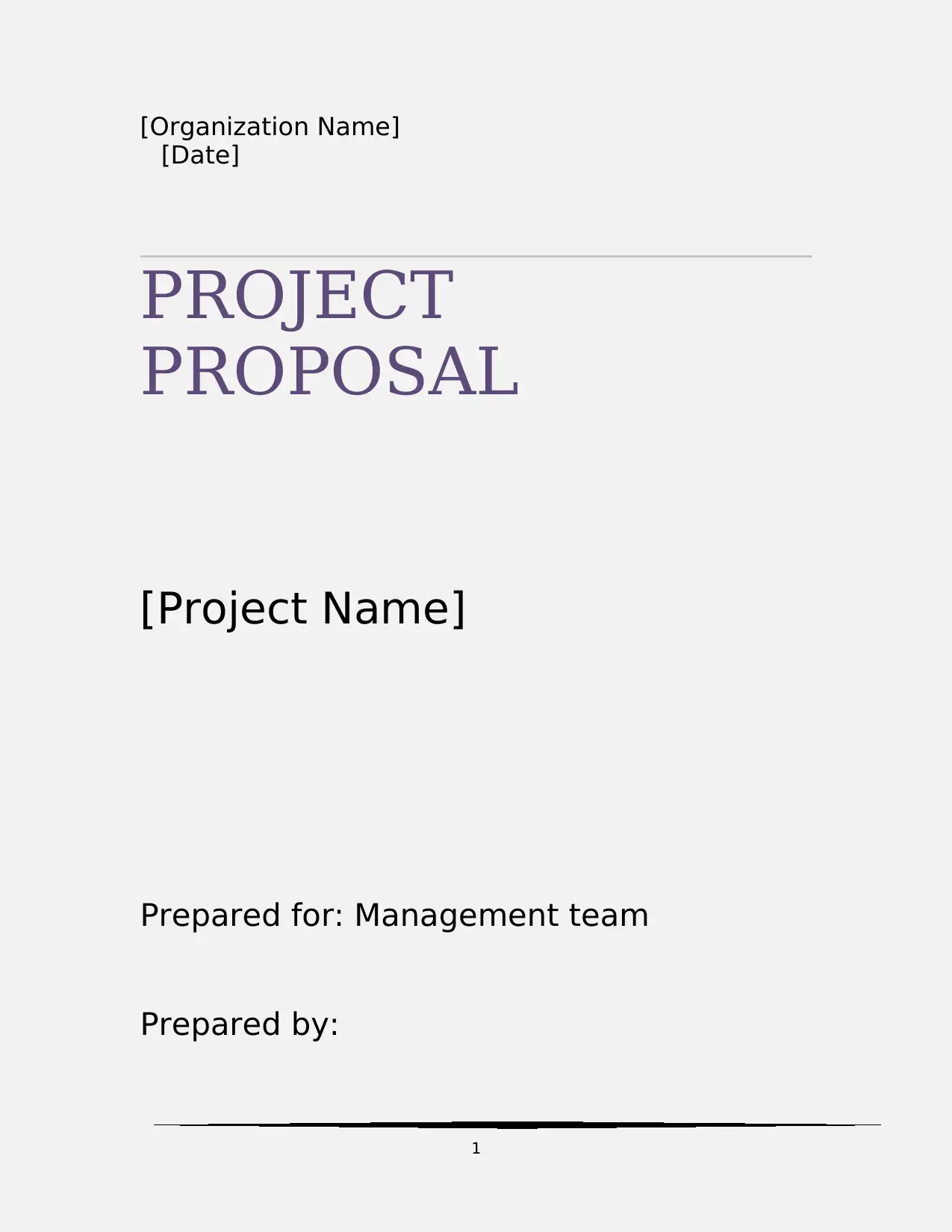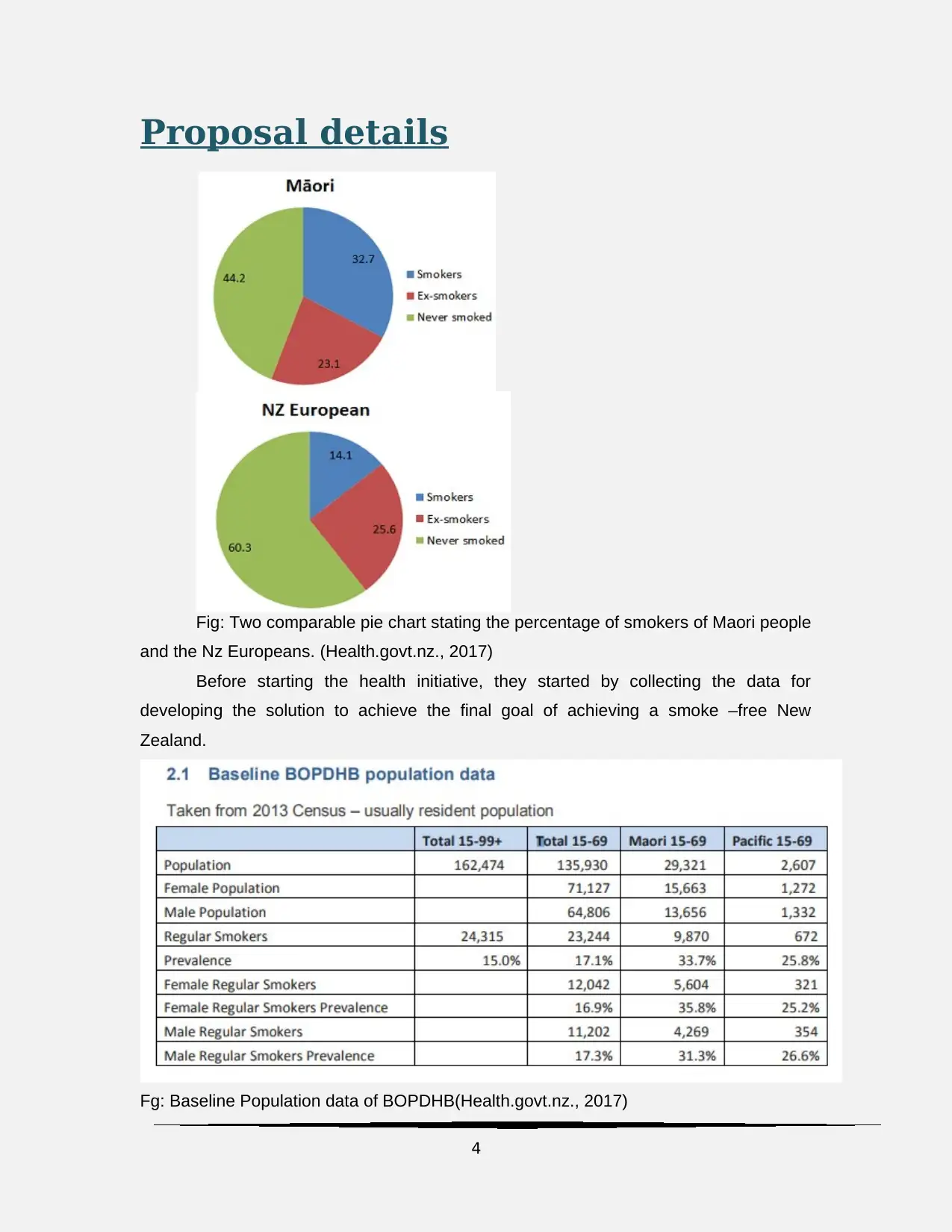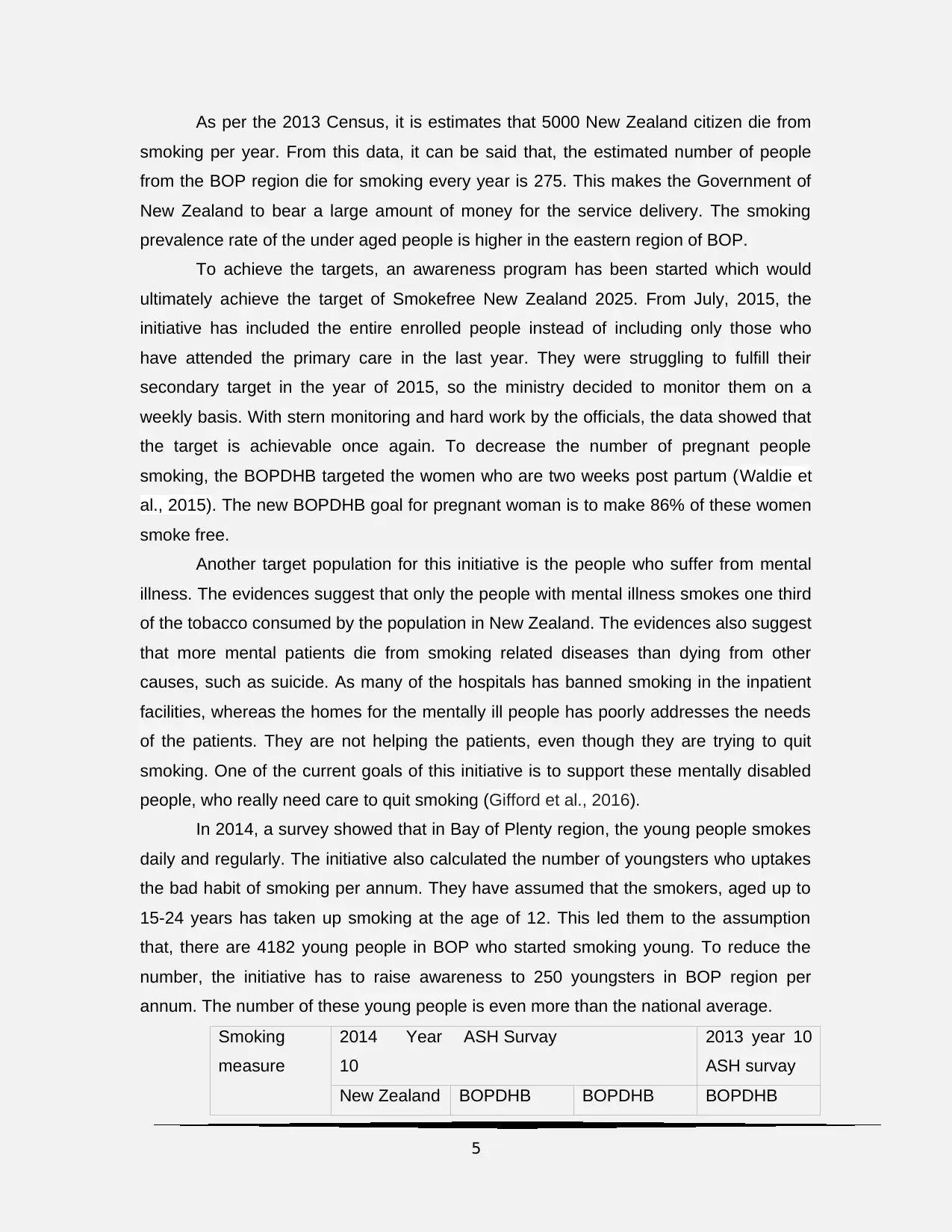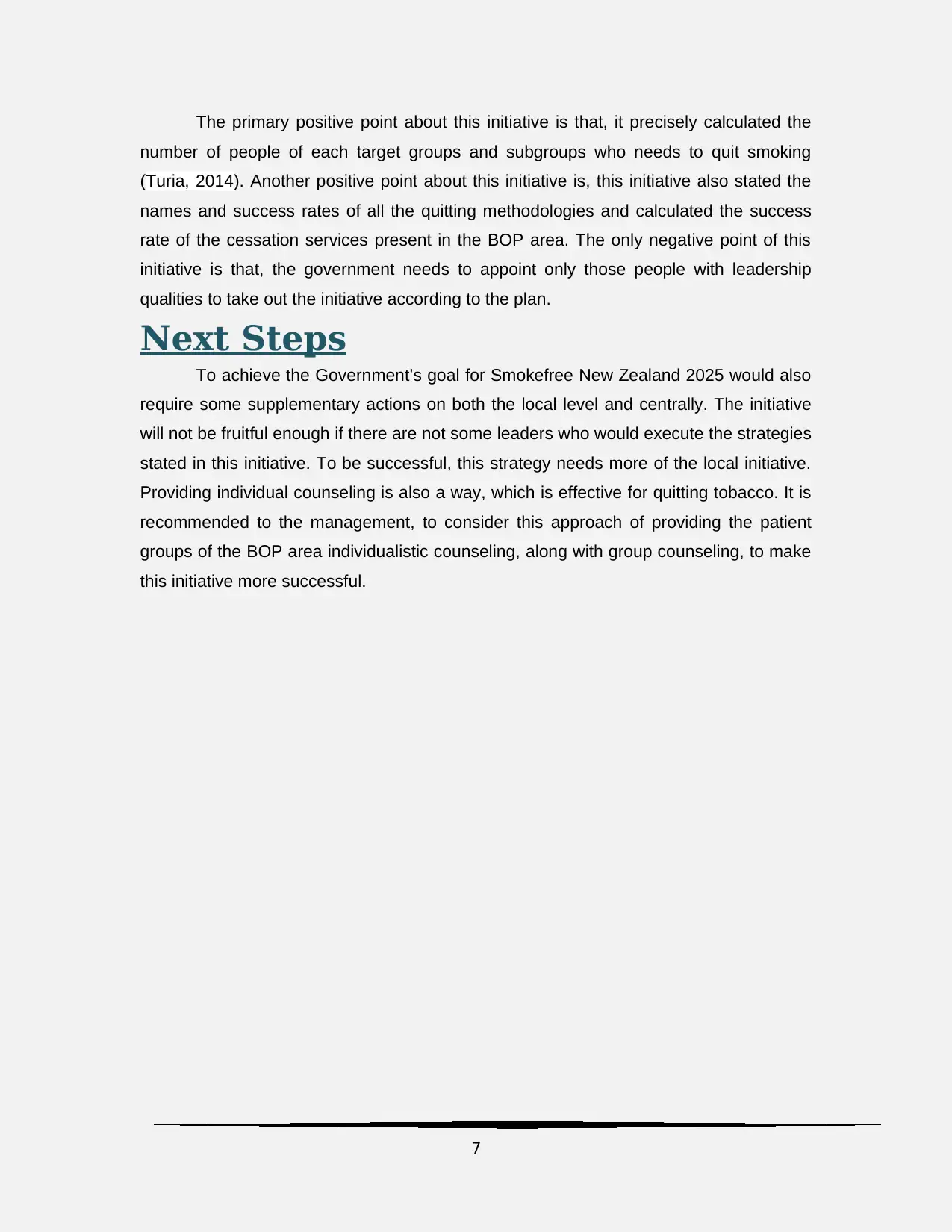Assessment of Smoking Cessation Strategies in New Zealand
VerifiedAdded on 2020/05/03
|9
|2386
|376
AI Summary
The assignment focuses on understanding the smoking trends in the Bay of Plenty district of New Zealand, with a particular emphasis on different ethnic groups such as Māori and Pacific populations. Data reveals varying smoking prevalence among these communities, with public health initiatives ...

[Organization Name]
[Date]
PROJECT
PROPOSAL
[Project Name]
Prepared for: Management team
Prepared by:
1
[Date]
PROJECT
PROPOSAL
[Project Name]
Prepared for: Management team
Prepared by:
1
Paraphrase This Document
Need a fresh take? Get an instant paraphrase of this document with our AI Paraphraser

Summary
Only 15% of the people in New Zealand have the bad habit of smoking, more or
less 5000 people in New Zealand die for many smoking related diseases. Tobacco is the
only carcinogenic commodity, which is legally available in the New Zealand. The Ministry
of health put an emphasis on the fact that smoking related deaths are preventable
(Ttophs.govt.nz., 2017). The reason of selecting the health target “better help for the
smokers to quit” is to support and achieve the government’s vision of creating a smoke
free New Zealand by 2025. The Government has set this target because; the evidence
suggested that creating smoke free environment is necessary as it would decrease the
overall number of youth up taking smoking. For the Bay of Plenty region, the government
has taken an initiative, named Tobacco control Strategic Action plan 2015-2018. The
reason to chose the region is the abundance of Maori people in that area and from the
record of Census 2015, in can be seen that the Maoris’ take up smoking at a very early
age. The action plan has specifically targeted the youth, the pregnant women and the
elderly to quit the bad habit.
Background
The Government has taken many health targets to secure the overall health service of
the country population. The national health target of “Better help for smokers to quit” is
chosen for this article. Smoking leaves a huge impact on the public health. Though 85%
of the total New Zealanders do not smoke, many of them are exposed to the threat of
passive smoking. The people of Maori tribe have the highest rate of smoking in New
Zealand (Glover et al., 2014). Smoking is common in those areas, which has the higher
number of Maori population. Bay of Plenty is one of the places with highest Maori
population. The reason of choosing this initiative is the mortality rate of the bay of plenty
due to smoking (Wilson, 2017).
The New Zealand Ministry of Health has made a target of creating smoke free
New Zealand by the year 2025. The New Zealand government has chosen an initiative
for controlling the use of Tobacco. It is estimated that in the Waikato region of the Bay of
Plenty area, there are approximately 43700 smokers of age 15 and over, which are more
or less 15.5% of the total population of Bay of Plenty. The chosen initiative which is
needed to fulfill the chosen National health target, is named Tobacco Control Strategic
2
Only 15% of the people in New Zealand have the bad habit of smoking, more or
less 5000 people in New Zealand die for many smoking related diseases. Tobacco is the
only carcinogenic commodity, which is legally available in the New Zealand. The Ministry
of health put an emphasis on the fact that smoking related deaths are preventable
(Ttophs.govt.nz., 2017). The reason of selecting the health target “better help for the
smokers to quit” is to support and achieve the government’s vision of creating a smoke
free New Zealand by 2025. The Government has set this target because; the evidence
suggested that creating smoke free environment is necessary as it would decrease the
overall number of youth up taking smoking. For the Bay of Plenty region, the government
has taken an initiative, named Tobacco control Strategic Action plan 2015-2018. The
reason to chose the region is the abundance of Maori people in that area and from the
record of Census 2015, in can be seen that the Maoris’ take up smoking at a very early
age. The action plan has specifically targeted the youth, the pregnant women and the
elderly to quit the bad habit.
Background
The Government has taken many health targets to secure the overall health service of
the country population. The national health target of “Better help for smokers to quit” is
chosen for this article. Smoking leaves a huge impact on the public health. Though 85%
of the total New Zealanders do not smoke, many of them are exposed to the threat of
passive smoking. The people of Maori tribe have the highest rate of smoking in New
Zealand (Glover et al., 2014). Smoking is common in those areas, which has the higher
number of Maori population. Bay of Plenty is one of the places with highest Maori
population. The reason of choosing this initiative is the mortality rate of the bay of plenty
due to smoking (Wilson, 2017).
The New Zealand Ministry of Health has made a target of creating smoke free
New Zealand by the year 2025. The New Zealand government has chosen an initiative
for controlling the use of Tobacco. It is estimated that in the Waikato region of the Bay of
Plenty area, there are approximately 43700 smokers of age 15 and over, which are more
or less 15.5% of the total population of Bay of Plenty. The chosen initiative which is
needed to fulfill the chosen National health target, is named Tobacco Control Strategic
2

Action Plan 2015-2018. The main aim of the initiative is to help the smokers to quit. The
initiative aims the government’s goal to make New Zealand smoke free until 2025
(Tautolo et al., 2014). The target group of this initiative is the Maori and pacific
population, pregnant women, parents of the children under the age of five years and the
people with mental illness. The initiative aims to half the current number of young people
who starts smoking at a young age (age range of 15-24) and to increase the number of
older people who successfully quits this bad habit of smoking ( age range-25-69). The
health Ministry of New Zealand has started to fund the health promotion, smoking
termination providers and the advocacy of the initiative directly and indirectly through the
BOPDHB Tobacco control agreement (Levy, Chaloupka, & Gitchell, 2004).
3
initiative aims the government’s goal to make New Zealand smoke free until 2025
(Tautolo et al., 2014). The target group of this initiative is the Maori and pacific
population, pregnant women, parents of the children under the age of five years and the
people with mental illness. The initiative aims to half the current number of young people
who starts smoking at a young age (age range of 15-24) and to increase the number of
older people who successfully quits this bad habit of smoking ( age range-25-69). The
health Ministry of New Zealand has started to fund the health promotion, smoking
termination providers and the advocacy of the initiative directly and indirectly through the
BOPDHB Tobacco control agreement (Levy, Chaloupka, & Gitchell, 2004).
3
⊘ This is a preview!⊘
Do you want full access?
Subscribe today to unlock all pages.

Trusted by 1+ million students worldwide

Proposal details
Fig: Two comparable pie chart stating the percentage of smokers of Maori people
and the Nz Europeans. (Health.govt.nz., 2017)
Before starting the health initiative, they started by collecting the data for
developing the solution to achieve the final goal of achieving a smoke –free New
Zealand.
Fg: Baseline Population data of BOPDHB(Health.govt.nz., 2017)
4
Fig: Two comparable pie chart stating the percentage of smokers of Maori people
and the Nz Europeans. (Health.govt.nz., 2017)
Before starting the health initiative, they started by collecting the data for
developing the solution to achieve the final goal of achieving a smoke –free New
Zealand.
Fg: Baseline Population data of BOPDHB(Health.govt.nz., 2017)
4
Paraphrase This Document
Need a fresh take? Get an instant paraphrase of this document with our AI Paraphraser

As per the 2013 Census, it is estimates that 5000 New Zealand citizen die from
smoking per year. From this data, it can be said that, the estimated number of people
from the BOP region die for smoking every year is 275. This makes the Government of
New Zealand to bear a large amount of money for the service delivery. The smoking
prevalence rate of the under aged people is higher in the eastern region of BOP.
To achieve the targets, an awareness program has been started which would
ultimately achieve the target of Smokefree New Zealand 2025. From July, 2015, the
initiative has included the entire enrolled people instead of including only those who
have attended the primary care in the last year. They were struggling to fulfill their
secondary target in the year of 2015, so the ministry decided to monitor them on a
weekly basis. With stern monitoring and hard work by the officials, the data showed that
the target is achievable once again. To decrease the number of pregnant people
smoking, the BOPDHB targeted the women who are two weeks post partum (Waldie et
al., 2015). The new BOPDHB goal for pregnant woman is to make 86% of these women
smoke free.
Another target population for this initiative is the people who suffer from mental
illness. The evidences suggest that only the people with mental illness smokes one third
of the tobacco consumed by the population in New Zealand. The evidences also suggest
that more mental patients die from smoking related diseases than dying from other
causes, such as suicide. As many of the hospitals has banned smoking in the inpatient
facilities, whereas the homes for the mentally ill people has poorly addresses the needs
of the patients. They are not helping the patients, even though they are trying to quit
smoking. One of the current goals of this initiative is to support these mentally disabled
people, who really need care to quit smoking (Gifford et al., 2016).
In 2014, a survey showed that in Bay of Plenty region, the young people smokes
daily and regularly. The initiative also calculated the number of youngsters who uptakes
the bad habit of smoking per annum. They have assumed that the smokers, aged up to
15-24 years has taken up smoking at the age of 12. This led them to the assumption
that, there are 4182 young people in BOP who started smoking young. To reduce the
number, the initiative has to raise awareness to 250 youngsters in BOP region per
annum. The number of these young people is even more than the national average.
Smoking
measure
2014 Year
10
ASH Survay 2013 year 10
ASH survay
New Zealand BOPDHB BOPDHB BOPDHB
5
smoking per year. From this data, it can be said that, the estimated number of people
from the BOP region die for smoking every year is 275. This makes the Government of
New Zealand to bear a large amount of money for the service delivery. The smoking
prevalence rate of the under aged people is higher in the eastern region of BOP.
To achieve the targets, an awareness program has been started which would
ultimately achieve the target of Smokefree New Zealand 2025. From July, 2015, the
initiative has included the entire enrolled people instead of including only those who
have attended the primary care in the last year. They were struggling to fulfill their
secondary target in the year of 2015, so the ministry decided to monitor them on a
weekly basis. With stern monitoring and hard work by the officials, the data showed that
the target is achievable once again. To decrease the number of pregnant people
smoking, the BOPDHB targeted the women who are two weeks post partum (Waldie et
al., 2015). The new BOPDHB goal for pregnant woman is to make 86% of these women
smoke free.
Another target population for this initiative is the people who suffer from mental
illness. The evidences suggest that only the people with mental illness smokes one third
of the tobacco consumed by the population in New Zealand. The evidences also suggest
that more mental patients die from smoking related diseases than dying from other
causes, such as suicide. As many of the hospitals has banned smoking in the inpatient
facilities, whereas the homes for the mentally ill people has poorly addresses the needs
of the patients. They are not helping the patients, even though they are trying to quit
smoking. One of the current goals of this initiative is to support these mentally disabled
people, who really need care to quit smoking (Gifford et al., 2016).
In 2014, a survey showed that in Bay of Plenty region, the young people smokes
daily and regularly. The initiative also calculated the number of youngsters who uptakes
the bad habit of smoking per annum. They have assumed that the smokers, aged up to
15-24 years has taken up smoking at the age of 12. This led them to the assumption
that, there are 4182 young people in BOP who started smoking young. To reduce the
number, the initiative has to raise awareness to 250 youngsters in BOP region per
annum. The number of these young people is even more than the national average.
Smoking
measure
2014 Year
10
ASH Survay 2013 year 10
ASH survay
New Zealand BOPDHB BOPDHB BOPDHB
5

ranking (out
of 20 districts)
district
Daily
smoking
2.81% 4.71% 16th 4.91%
Regular
smoking
6.05% 9.16% 18th 7.99%
Never
smoked
76.0% 71.66% 14th 72.21%
Fig: Rate of young regular smokers in Bay of Plenty (BOP)(Health.govt.nz., 2017)
The health ministry has a target of reducing the number of Maori smokers to less
than 18% by the year 2018. The initiative has even calculated the number of people who
needs to quit this habit completely in the following list. In this list there is the exact
number of Maori population who needs to quit this habit completely.
Group Total Per annum
All Maori 4600 920
Maori Males 1814 360
Maori Females 2786 560
Fig: The exact number of Maori population who needs to quit smoking (Health.govt.nz.,
2017)
The initiative has finally assumed that, to achieve the ultimate goal of smoke free
2025, they need to achieve as more as 15 quits every year in all the patient groups per
annum until 2015.
The initiative has even measured the success rates per methodologies. They
have reported that group counseling has more success rates than the other
methodologies. The initiative also pointed out the pharmacotherapy options according to
the NZ guidelines (Muriwai, 2016).
The initiative even pointed out the success rates of all the smoking cessation
services in the BOP area, namely Quitline, Ngati Awa social and health service,
BOPDHB planning and Funding, Smokefree DHBs and Tobacco control capacity (Mistry,
Broadbent, & Murray, 2016). The ministry of Health, New Zealand is providing the
required funding for the national cessation, media campaigns, locally provided cessation
training, regulatory services and promotions. The ministry provides the funding in Bay of
Plenty area for controlling the use of Tobacco through BOPDHB, Toi Te Ora-Public
health services and the AKP providers (van Esdonk et al., 2014).
6
of 20 districts)
district
Daily
smoking
2.81% 4.71% 16th 4.91%
Regular
smoking
6.05% 9.16% 18th 7.99%
Never
smoked
76.0% 71.66% 14th 72.21%
Fig: Rate of young regular smokers in Bay of Plenty (BOP)(Health.govt.nz., 2017)
The health ministry has a target of reducing the number of Maori smokers to less
than 18% by the year 2018. The initiative has even calculated the number of people who
needs to quit this habit completely in the following list. In this list there is the exact
number of Maori population who needs to quit this habit completely.
Group Total Per annum
All Maori 4600 920
Maori Males 1814 360
Maori Females 2786 560
Fig: The exact number of Maori population who needs to quit smoking (Health.govt.nz.,
2017)
The initiative has finally assumed that, to achieve the ultimate goal of smoke free
2025, they need to achieve as more as 15 quits every year in all the patient groups per
annum until 2015.
The initiative has even measured the success rates per methodologies. They
have reported that group counseling has more success rates than the other
methodologies. The initiative also pointed out the pharmacotherapy options according to
the NZ guidelines (Muriwai, 2016).
The initiative even pointed out the success rates of all the smoking cessation
services in the BOP area, namely Quitline, Ngati Awa social and health service,
BOPDHB planning and Funding, Smokefree DHBs and Tobacco control capacity (Mistry,
Broadbent, & Murray, 2016). The ministry of Health, New Zealand is providing the
required funding for the national cessation, media campaigns, locally provided cessation
training, regulatory services and promotions. The ministry provides the funding in Bay of
Plenty area for controlling the use of Tobacco through BOPDHB, Toi Te Ora-Public
health services and the AKP providers (van Esdonk et al., 2014).
6
⊘ This is a preview!⊘
Do you want full access?
Subscribe today to unlock all pages.

Trusted by 1+ million students worldwide

The primary positive point about this initiative is that, it precisely calculated the
number of people of each target groups and subgroups who needs to quit smoking
(Turia, 2014). Another positive point about this initiative is, this initiative also stated the
names and success rates of all the quitting methodologies and calculated the success
rate of the cessation services present in the BOP area. The only negative point of this
initiative is that, the government needs to appoint only those people with leadership
qualities to take out the initiative according to the plan.
Next Steps
To achieve the Government’s goal for Smokefree New Zealand 2025 would also
require some supplementary actions on both the local level and centrally. The initiative
will not be fruitful enough if there are not some leaders who would execute the strategies
stated in this initiative. To be successful, this strategy needs more of the local initiative.
Providing individual counseling is also a way, which is effective for quitting tobacco. It is
recommended to the management, to consider this approach of providing the patient
groups of the BOP area individualistic counseling, along with group counseling, to make
this initiative more successful.
7
number of people of each target groups and subgroups who needs to quit smoking
(Turia, 2014). Another positive point about this initiative is, this initiative also stated the
names and success rates of all the quitting methodologies and calculated the success
rate of the cessation services present in the BOP area. The only negative point of this
initiative is that, the government needs to appoint only those people with leadership
qualities to take out the initiative according to the plan.
Next Steps
To achieve the Government’s goal for Smokefree New Zealand 2025 would also
require some supplementary actions on both the local level and centrally. The initiative
will not be fruitful enough if there are not some leaders who would execute the strategies
stated in this initiative. To be successful, this strategy needs more of the local initiative.
Providing individual counseling is also a way, which is effective for quitting tobacco. It is
recommended to the management, to consider this approach of providing the patient
groups of the BOP area individualistic counseling, along with group counseling, to make
this initiative more successful.
7
Paraphrase This Document
Need a fresh take? Get an instant paraphrase of this document with our AI Paraphraser

References
Gifford, H., Tautolo, E. S., Erick, S., Hoek, J., Gray, R., & Edwards, R. (2016). A
qualitative analysis of Māori and Pacific smokers9 views on informed choice
and smoking. BMJ open, 6(5), e011415. Retrieved from
http://bmjopen.bmj.com/content/6/5/e011415.full
Glover, M., Nosa, V., Gentles, D., Watson, D., & Paynter, J. (2014). Do New Zealand
Māori and Pacific ‘walk the talk’when it comes to stopping smoking? A
qualitative study of motivation to quit. Journal of Smoking Cessation, 9(2), 68-
75. Doi: 10.1017/jsc.2013.22
Health.govt.nz. (2017). Tobacco Control Strategic Action Plan 2015-2018. Bay of
Plenty District Health Board. Retrieved from
https://www.health.govt.nz/system/files/documents/pages/bay_of_plenty_dhb_
tobacco_control_plan.pdf
Levy, D. T., Chaloupka, F., & Gitchell, J. (2004). The effects of tobacco control policies
on smoking rates: a tobacco control scorecard. Journal of Public Health
Management and Practice, 10(4), 338-353. Retrieved from-
https://s3.amazonaws.com/academia.edu.documents/43423256/The_effects_o
f_tobacco_control_policies_20160306-6427-1df7lmz.pdf?
AWSAccessKeyId=AKIAIWOWYYGZ2Y53UL3A&Expires=1509435398&Signatur
e=gVIPNTISLy8x6TOH9sqzpWHE1fY%3D&response-content-disposition=inline
%3B%20filename%3DThe_Effects_of_Tobacco_Control_Policies.pdf
Mistry, D., Broadbent, J., & Murray, C. (2016). Smoking Cessation Interventions
Amongst New Zealand Dental Students: A Survey. Journal of Smoking
Cessation, 1-9. Doi: 10.1017/jsc.2016.19
Muriwai, E. (2016). Smoking, Not Our Tikanga: An Analysis of Māori Identity and
Smoking Behaviour (Doctoral dissertation, University of Auckland). Retrieved
from
https://www.researchgate.net/profile/Emerald_Muriwai/publication/309458614
_Smoking_Not_Our_Tikanga_An_Analysis_of_Maori_Identity_and_Smoking_Beh
aviour/links/5811341208aea04bbcbd52bf.pdf
Tautolo, E. S., Iusitini, L., Taylor, S., & Paterson, J. (2014). Will New Zealand be
smokefree by 2025? Smoking prevalence amongst a cohort of Pacific
adults. The New Zealand Medical Journal (Online), 127(1393). Retrieved from
https://search.proquest.com/openview/bc17f038cc82023c8a875265f6781593/
1?pq-origsite=gscholar&cbl=1056335
Ttophs.govt.nz. (2017). A collection of Health Promotion initiatives within the Bay of
Plenty district Retrieved from https://www.ttophs.govt.nz/vdb/document/287
Turia, H. T. (2014). Back to Back: Cigarettes should be sold in plain packaging in New
Zealand: Yes. Journal of primary health care, 6(2), 157-158. Retrieved from
https://core.ac.uk/download/pdf/25712884.pdf
van Esdonk, T., Glover, M., Kira, A., & Wagemakers, A. (2014). Reducing smoking in
pregnancy among Māori women:“aunties” perceptions and willingness to
help. Maternal and child health journal, 18(10), 2316-2322. Retrieved from
https://s3.amazonaws.com/academia.edu.documents/41915533/Reducing_Sm
oking_in_Pregnancy_Among_MAor20160202-22095-6ista9.pdf?
AWSAccessKeyId=AKIAIWOWYYGZ2Y53UL3A&Expires=1509435974&Signatur
e=%2Bj%2FI4FhBDqClJ77RMM5qcOGqW7k%3D&response-content-
disposition=inline%3B%20filename
%3DReducing_Smoking_in_Pregnancy_Among_Maor.pdf
Waldie, K. E., Peterson, E. R., D'Souza, S., Underwood, L., Pryor, J. E., Carr, P. A., ... &
Morton, S. M. (2015). Depression symptoms during pregnancy: evidence from
8
Gifford, H., Tautolo, E. S., Erick, S., Hoek, J., Gray, R., & Edwards, R. (2016). A
qualitative analysis of Māori and Pacific smokers9 views on informed choice
and smoking. BMJ open, 6(5), e011415. Retrieved from
http://bmjopen.bmj.com/content/6/5/e011415.full
Glover, M., Nosa, V., Gentles, D., Watson, D., & Paynter, J. (2014). Do New Zealand
Māori and Pacific ‘walk the talk’when it comes to stopping smoking? A
qualitative study of motivation to quit. Journal of Smoking Cessation, 9(2), 68-
75. Doi: 10.1017/jsc.2013.22
Health.govt.nz. (2017). Tobacco Control Strategic Action Plan 2015-2018. Bay of
Plenty District Health Board. Retrieved from
https://www.health.govt.nz/system/files/documents/pages/bay_of_plenty_dhb_
tobacco_control_plan.pdf
Levy, D. T., Chaloupka, F., & Gitchell, J. (2004). The effects of tobacco control policies
on smoking rates: a tobacco control scorecard. Journal of Public Health
Management and Practice, 10(4), 338-353. Retrieved from-
https://s3.amazonaws.com/academia.edu.documents/43423256/The_effects_o
f_tobacco_control_policies_20160306-6427-1df7lmz.pdf?
AWSAccessKeyId=AKIAIWOWYYGZ2Y53UL3A&Expires=1509435398&Signatur
e=gVIPNTISLy8x6TOH9sqzpWHE1fY%3D&response-content-disposition=inline
%3B%20filename%3DThe_Effects_of_Tobacco_Control_Policies.pdf
Mistry, D., Broadbent, J., & Murray, C. (2016). Smoking Cessation Interventions
Amongst New Zealand Dental Students: A Survey. Journal of Smoking
Cessation, 1-9. Doi: 10.1017/jsc.2016.19
Muriwai, E. (2016). Smoking, Not Our Tikanga: An Analysis of Māori Identity and
Smoking Behaviour (Doctoral dissertation, University of Auckland). Retrieved
from
https://www.researchgate.net/profile/Emerald_Muriwai/publication/309458614
_Smoking_Not_Our_Tikanga_An_Analysis_of_Maori_Identity_and_Smoking_Beh
aviour/links/5811341208aea04bbcbd52bf.pdf
Tautolo, E. S., Iusitini, L., Taylor, S., & Paterson, J. (2014). Will New Zealand be
smokefree by 2025? Smoking prevalence amongst a cohort of Pacific
adults. The New Zealand Medical Journal (Online), 127(1393). Retrieved from
https://search.proquest.com/openview/bc17f038cc82023c8a875265f6781593/
1?pq-origsite=gscholar&cbl=1056335
Ttophs.govt.nz. (2017). A collection of Health Promotion initiatives within the Bay of
Plenty district Retrieved from https://www.ttophs.govt.nz/vdb/document/287
Turia, H. T. (2014). Back to Back: Cigarettes should be sold in plain packaging in New
Zealand: Yes. Journal of primary health care, 6(2), 157-158. Retrieved from
https://core.ac.uk/download/pdf/25712884.pdf
van Esdonk, T., Glover, M., Kira, A., & Wagemakers, A. (2014). Reducing smoking in
pregnancy among Māori women:“aunties” perceptions and willingness to
help. Maternal and child health journal, 18(10), 2316-2322. Retrieved from
https://s3.amazonaws.com/academia.edu.documents/41915533/Reducing_Sm
oking_in_Pregnancy_Among_MAor20160202-22095-6ista9.pdf?
AWSAccessKeyId=AKIAIWOWYYGZ2Y53UL3A&Expires=1509435974&Signatur
e=%2Bj%2FI4FhBDqClJ77RMM5qcOGqW7k%3D&response-content-
disposition=inline%3B%20filename
%3DReducing_Smoking_in_Pregnancy_Among_Maor.pdf
Waldie, K. E., Peterson, E. R., D'Souza, S., Underwood, L., Pryor, J. E., Carr, P. A., ... &
Morton, S. M. (2015). Depression symptoms during pregnancy: evidence from
8

growing up in New Zealand. Journal of affective disorders, 186, 66-73.
Retrieved from
https://researchspace.auckland.ac.nz/bitstream/handle/2292/30580/Antenatal
%20depression%20JADwithcoversheet.pdf?sequence=26
Wilson, N. (2017) International Tobacco Control (ITC) Policy Evaluation Project 2016-
2018 - New Zealand (ITC Project)(Updated 2017). Wellington: University of
Otago, Wellington, 2017. Retrieved from
http://www.otago.ac.nz/wellington/departments/publichealth/research/
otago577201.html
9
Retrieved from
https://researchspace.auckland.ac.nz/bitstream/handle/2292/30580/Antenatal
%20depression%20JADwithcoversheet.pdf?sequence=26
Wilson, N. (2017) International Tobacco Control (ITC) Policy Evaluation Project 2016-
2018 - New Zealand (ITC Project)(Updated 2017). Wellington: University of
Otago, Wellington, 2017. Retrieved from
http://www.otago.ac.nz/wellington/departments/publichealth/research/
otago577201.html
9
⊘ This is a preview!⊘
Do you want full access?
Subscribe today to unlock all pages.

Trusted by 1+ million students worldwide
1 out of 9
Related Documents
Your All-in-One AI-Powered Toolkit for Academic Success.
+13062052269
info@desklib.com
Available 24*7 on WhatsApp / Email
![[object Object]](/_next/static/media/star-bottom.7253800d.svg)
Unlock your academic potential
© 2024 | Zucol Services PVT LTD | All rights reserved.





